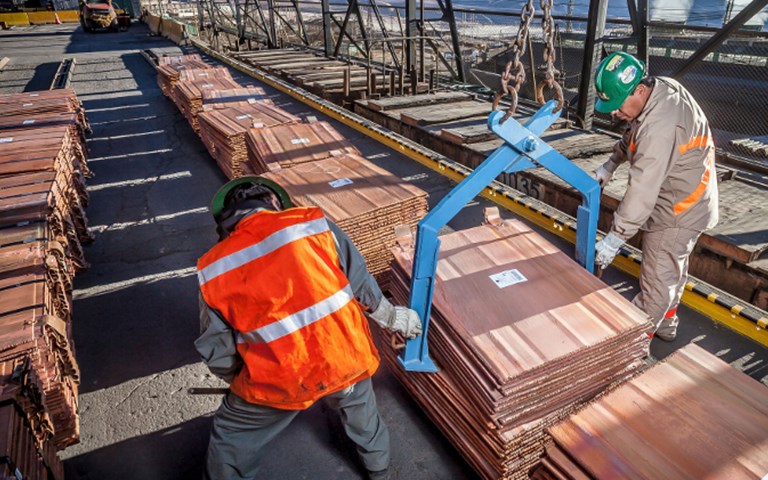Workers inspect copper cathodes at Codelco's Salvador operations in Chile. Copper looks set for solid growth throughout 2018 and into 2019 after a December rally. Courtesy of Codelco/Flickr/Patio Embarque
Despite political turbulence in much of the world, commodities markets look bullish throughout 2018 based on economic forecasts and market analysis, with upward trends poised to extend to most base metals, crude oil and natural gas. Projections by the World Bank, Goldman Sachs and Canadian firms like Scotiabank all indicate strong growth and stable markets for the coming year.
“For the first time in years, global economies, both advanced and emerging, are growing or accelerating in sync, with very little in the way of contractions,” said Scotiabank commodities economist Rory Johnston, noting that no single factor tells the whole story. “It’s a virtuous circle. One of the big turnarounds has been Europe going from a drag on global growth to actually stimulating global growth, which has a positive spinoff for countries that trade with Europe, which has cascaded down the entire global economy, including to Canada.”
Upward commodity trends that began in 2017 are expected to edge up throughout 2018 and into 2019, based in part on continued stability from Chinese manufacturing markets.
“The commodity market has shifted in the last 12 months, so we’re in a situation now where we’ve got this synchronized optimism, underpinned by this belief in a stronger than expected global economy,” said Paul Robinson, a director at CRU Group. “That puts the commodity markets in a good position, though we’re still very much reliant on what happens in China from a demand perspective. What is still unfolding is what China may do from a supply perspective to restrict production across a range of commodities due to environmental considerations.”
Related: Cobalt and palladium 2017’s big winners, while Canadian crude and uranium slump
This year’s base metal darlings are cobalt, zinc and nickel. In the cases of cobalt and nickel, this has been at least partially attributed to investment in electric vehicle technology, which is expected to rise as production and affordability of newer models grows. As lithium-ion batteries for both light and heavy-duty vehicles become more cost-efficient, the demand for their base metal ingredients is expected to grow steadily along with prices.
S&P Global Platts expects global electric vehicle sales to rise 1,300 per cent from 2015 to 2025, and battery manufacturing capacity to more than double by 2021. So the real question is not whether base metal prices will increase, but whether miners will be able to keep up with exponential demand from that sector.
For zinc, market fundamentals are still in its favour. “Globally, zinc is in tight supply and production of refined zinc may struggle to keep pace with demand,” said Joe Innace, S&P’s Americas’ metals content director.
Copper rallied steadily throughout December, and looks set for solid growth throughout 2018 and into 2019, keeping it in line with its nickname ‘Doctor Copper’ as a marker for assessing the global industrial cycle. This is driven in part by speculative financial investors building long positions, according to Andy Blamey, the associate editorial director of metals pricing with S&P. “Fundamentals remain broadly supportive and with numerous labour contracts up for renewal this year, particularly in Chile and Peru, the market may be factoring in a disruption risk premium.”
Iron ore prices are expected to average $60 in 2018, down from $72 from the previous year, according to Scotiabank. This is due in part to market oversupply from low-cost producers like Australia and Brazil, which are both forecasted to increase production. China’s steel output was higher than expected in 2017, but Beijing has announced plans to cut capacity 10 per cent by 2021 to battle air pollution. The China Metallurgical Industry Planning and Research Institute projected output to rise 0.7 per cent to 838 million tonnes in 2018, compared to a three per cent increase in 2017. The volatility of iron ore will depend on China, but Goldman Sachs is keeping its projection bearish on the risk of steel production topping in the world’s biggest producer.
According to the World Bank, oil prices are projected to average $58 per barrel in 2018, up from $53 in 2017, with supply growing at half the pace of global demand. The extension in late November of an OPEC output cut until the end of 2018 led Goldman Sachs to revise up its forecast for oil prices. However, this depends heavily on OPEC members continuing to comply with the terms of the deal, especially amid an ongoing political rift in the Arabian Gulf.
“As of December, OPEC members have reached all-time high levels of compliance. This burden is being shared much more evenly among major segments, though it wasn’t always the case,” said Johnston. “This initially raised fears around potential defection from the agreement. However, we see them now much more evenly contributing to the deal, which is generally bullish on the outlook for the agreement and oil prices.”
Other risk factors for the energy market include supply disruptions from turbulent countries like Libya, Iraq, and Nigeria, as well as ongoing political and economic turmoil in Venezuela. If the United States reduces Mexican imports, demand for heavy Alberta crude could boost Canada’s market share with increased access to U.S. refining capacity, according to a projection released by Deloitte.
Unfolding events in 2018 like NAFTA renegotiations, Chinese stimulus withdrawals, Brexit and new tax policies in the U.S. will also have unforeseen effect on markets throughout the year, though most analyses are nonetheless positive.
“You could have drawn forecasts for 20 events that would have turned markets last year, and another 20 that could turn it this year,” said Robinson. “But based on what’s before us, we see relatively little downside. What’s more important now is looking for what will give more upside than speculating on major risks we can’t foresee.”



